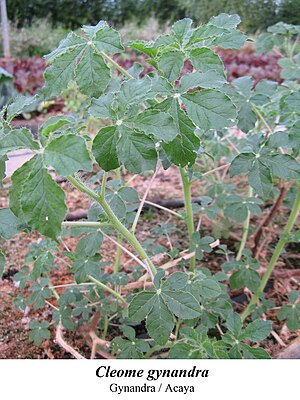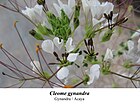Note: This is a project under development. The articles on this wiki are just being initiated and broadly incomplete. You can Help creating new pages.
Cleome gynandra - Ajagandha
Ajagandhā consists of the seeds of Cleome gynandra Linn. Syn. Gynandropsis gynandra (Linn.) Briquet (Fam. Capparidaceae), a strong smelling, somewhat foetid herb, 0.6 - 1 m high, found abundantly throughout warmer parts of India.
Contents
- 1 Uses
- 2 Parts Used
- 3 Chemical Composition
- 4 Common names
- 5 Properties
- 6 Habit
- 7 Identification
- 8 List of Ayurvedic medicine in which the herb is used
- 9 Where to get the saplings
- 10 Mode of Propagation
- 11 How to plant/cultivate
- 12 Commonly seen growing in areas
- 13 Photo Gallery
- 14 References
- 15 External Links
Uses
Mouth sores, Bleeding piles, Leucorrhoea, Mild diabetes, Cough, Physical weakness, Ulcer, Urinary trouble, Snakebite, Infection in intestine.
Parts Used
Chemical Composition
Fixed oil, essential oil, oleoresin, Carotenoids, Cardiac glycosides, Cyanogenic Glycosides, Flavonoids, Saponins, Triterpenes, sugars, Tannins etc.[1]
Common names
| Language | Common name |
|---|---|
| Kannada | Naram bele Soppu, Nayeetulasi |
| Hindi | Hulhul, Hurhur, Kavalia |
| Malayalam | Atunari vela |
| Tamil | Nal valai, Nal velai |
| Telugu | Vaminta, Vayinta |
| Marathi | Tilvan, Bhatvan, Mabli, Tilavana, Tilvant |
| Gujarathi | Talvani, Dhelitalavan |
| Punjabi | Bugra |
| Kashmiri | Gandi Buti |
| Sanskrit | Pashughandha |
| English | Dog Mustard |
Properties
Reference: Dravya - Substance, Rasa - Taste, Guna - Qualities, Veerya - Potency, Vipaka - Post-digesion effect, Karma - Pharmacological activity, Prabhava - Therepeutics.
Dravya
Rasa
Katu (Pungent)
Guna
Laghu (Light), Ruksha (Dry)
Veerya
Sheeta (Cold)
Vipaka
Katu (Pungent)
Karma
Kaphahara, Vatahara, Deepana, Hridya
Prabhava
Habit
Identification
Leaf
| Kind | Shape | Feature |
|---|---|---|
| Digitate | Alternate | Leaf Arrangementis Alternate-spiralLeaves digitately 5-7 foliate; leaflets 5 x 2.5 cm, obovate; petiole 3-15 cm. |
Flower
| Type | Size | Color and composition | Stamen | More information |
|---|---|---|---|---|
| Bisexual | 1.5 cm across | white | 5 | Flowering throughout the year and In terminal and/or axillary pseudoracemes calyx lobes unequal, glandular, pubescent; petals long clawed, spreading; stamens 6, attached to the long gynandrophore; ovary glandular. |
Fruit
| Type | Size | Mass | Appearance | Seeds | More information |
|---|---|---|---|---|---|
| Capsule | 3-4 cm long terete, glandular, tip discoid. | seeds upto 5 | Fruiting throughout the year |
Other features
List of Ayurvedic medicine in which the herb is used
Where to get the saplings
Mode of Propagation
How to plant/cultivate
Commonly seen growing in areas
Open areas, Waste places, Cultivated and Uncultivated land.
Photo Gallery
References
- ↑ "chemistry"
- ↑ [FLOWERING PLANTS OF KERALA VER 2.0, N.SASIDHARAN "morphology"]
External Links
- Pages that are stubs
- Ayurvedic Herbs known to be helpful to treat Mouth sores
- Ayurvedic Herbs known to be helpful to treat Bleeding piles
- Ayurvedic Herbs known to be helpful to treat Leucorrhoea
- Ayurvedic Herbs known to be helpful to treat Mild diabetes
- Ayurvedic Herbs known to be helpful to treat Cough
- Ayurvedic Herbs known to be helpful to treat Physical weakness
- Ayurvedic Herbs known to be helpful to treat Ulcer
- Ayurvedic Herbs known to be helpful to treat Urinary trouble
- Ayurvedic Herbs known to be helpful to treat Snakebite
- Ayurvedic Herbs known to be helpful to treat Infection in intestine
- Herbs with Seeds used in medicine
- Herbs with Stem used in medicine
- Herbs with Leaves used in medicine
- Herbs with Roots used in medicine
- Herbs with common name in Kannada
- Herbs with common name in Hindi
- Herbs with common name in Malayalam
- Herbs with common name in Tamil
- Herbs with common name in Telugu
- Herbs with common name in Marathi
- Herbs with common name in Gujarathi
- Herbs with common name in Punjabi
- Herbs with common name in Kashmiri
- Herbs with common name in Sanskrit
- Herbs with common name in English
- Habit - Annual Erect
- Index of Plants which can be propagated by Seeds
- Herbs that are commonly seen in the region of Open areas
- Herbs that are commonly seen in the region of Waste places
- Herbs that are commonly seen in the region of Cultivated and Uncultivated land
- Ayurvedic Pharmacopedia of India
- Herbs






